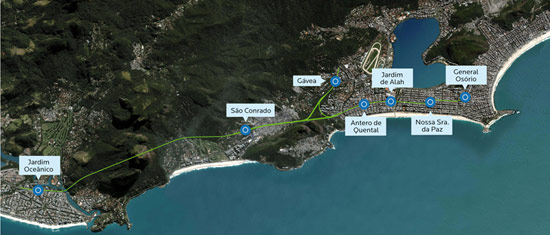Rio-bound EPBM to forge vital Olympic metro link
Sep 2012
Peter Kenyon, TunnelTalk
- Preparations for the Rio de Janeiro Olympic Games in 2016 are boosted by factory acceptance of the 11.46m diameter Herrenknecht machine that will complete the historic Brazilian city's first ever TBM drive.
- The convertible EPBM will excavate a coastal 5.7km section of a total 16km alignment that will for the first time link via underground subway the old city in the east with the Olympic Park and Olympic village sites in the more fashionable Barra da Tijuca suburbs west of the Pedra Branca mountains (Fig 1).
-

Fig 1. Herrenknecht 10.46m TBM will excavate the 5.7km General Osório-Gávea alignment
- The project was first tendered in 1998 but has been through a number of alignment changes until construction finally started in 2010. It is considered a vital transportation link by the International Olympic Committee because most of the events of the 2016 Games will take place at the Olympic Park in Barra, which is currently not connected to Rio's small two-line metro system.
-

Cut-and-cover station site at Barra. The track will cross the Largo de Barra and enter the mountain via a bridge crossing
- Construction of the 10km drill+blast section through the mountains and the Tijuca Forest Park (Lot 1) between new cut-and-cover stations in Barra (Jardim Oceânico) and Gávea is being carried out by the Consórcio Construtor Rio Barra (CCRB), a joint venture led by Queiroz Galvão with partner companies Odebrecht Infraestrutura, Carioca Engenharia, Cowan and Servix.
- "The drill+blast part of the project broke ground in São Condrado in August 2010, and to date 3.3km has been excavated," said a spokeman for Concessionária Rio Barra (CRB), the public-private partnership that is completing the works.
- He added: "An EPBM was selected for the 5.7km alignment between General Osório and Gávea because the coastal location means ground conditions will be a mix of sand, silt, clay and rock. Additionally restrictions on blasting in the built up areas of Ipanema and Leblon would have made this form of construction difficult. This will be the first time a TBM has been used in Rio de Janeiro."
- He added: "Six new underground stations are being constructed as part of the project, and one feature of the design at Gavea is that it will incorporate the possibility for a new extension of the line northwards."
- The TBM alignment (Lot 2) between Gávea and the junction with General Osório Station will be completed to a depth of 12m by the Consórcio Linha 4 Sul, a joint venture led by Odebrecht Infraestrutura with partner companies Carioca Engenharia and Queiroz Galvão.
- The Herrenknecht EPBM is due to be shipped to Rio in 19 containers in July next year (2013), ready for assembly, testing and launch the following month, the CRB spokesman told TunnelTalk from Brazil yesterday (26 September, 2012).
-

Bridge entrance to the 10km tunnel just outside the Olympic Park station (Jardim Oceânico) in Barra. From here the tunnel will cross the Tijuca National Park to Gávea
- The equipment for production of the necessary 19,000 concrete segments that will line the 10.33m i.d. tunnel are supplied by Herrenknecht Formwork.
- Marcus Vidigal, Odebrecht Project Director said: "We will use this convertible EPB-TBM in sandy and rocky soils, such as those found in Ipanema and Leblon. Without the TBM, we would have to dig trenches in the sandy stretches, which would cause a major headache for local residents."
- In addition to the drill+blast headings, construction work has also started on the stations at Barra and São Conrado, as has construction of the TBM launch site just outside General Osório Station at the easternmost end where the new line will eventually link with Rio's only other two metro lines - Line 1 and 2 (Fig 2).
- Work has also now started on other cut-and-cover stations in the eastern section along the TBM alignment, after an injunction that had prevented works continuing was lifted by the courts in April this year (2012).
- Work is sceduled to complete on Line 4 in December 2015, with the Olympics taking place just six months later. When complete it is anticipated that 300,000 people will use the line daily, and that 2,000 vehicles per hour will be removed from Rio's busy streets at peak hours.
- Plans to extend the new Line 4 northwards from Gávea to the old city centre are currently in the design phase, with local media sources claiming that the State Government of Rio, which runs the metro system via a concession, will call for expressions of interest in December this year (2012).
-
Rio prepares for international Games - TunnelTalk, October 2011
Brazilian port tunnel sets new standards - TunnelTalk, January 2012
Sao Paolo urban forest tunnels edge closer - TunnelTalk, June 2012
|
|
|
|
|
Add your comment
- Thank you for taking the time to share your thoughts and comments. You share in the wider tunnelling community, so please keep your comments smart and civil. Don't attack other readers personally, and keep your language professional.


